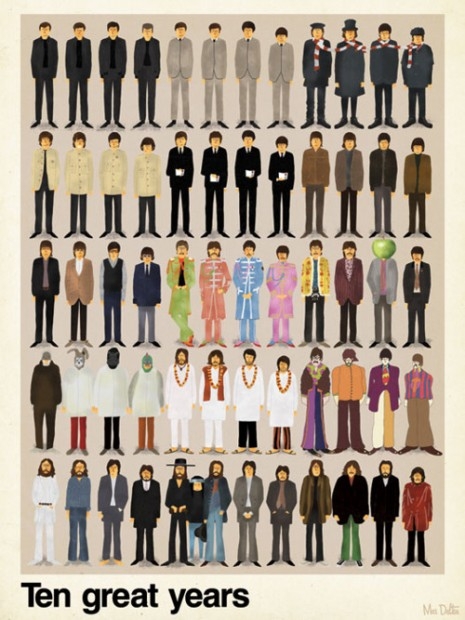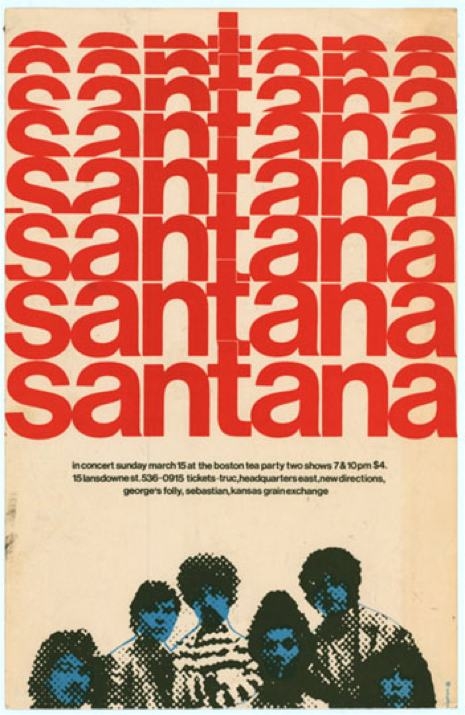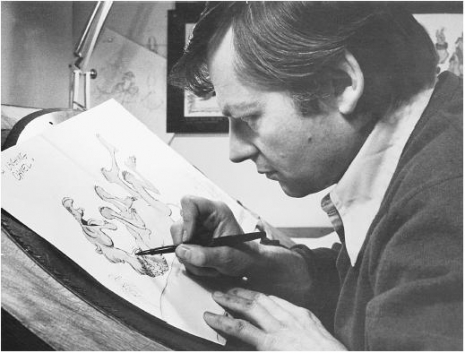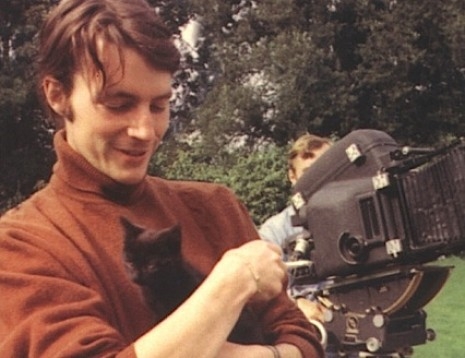
Here’s a stylish limted edition print by Argentinean-based artist Maxim Dalton. You can order “Ten Great Years” for $55.99 here.
See close-ups of the print after the jump…

Here’s a stylish limted edition print by Argentinean-based artist Maxim Dalton. You can order “Ten Great Years” for $55.99 here.
See close-ups of the print after the jump…

David Bowie first released “Moonage Daydream” under the project name Arnold Corns, which was one of Bowie’s side interests, a group set up for 19-year-old dress designer Freddie Burrettia to front. The original band had been assembled in Dulwich College, the name inspired by Pink Floyd’s song “Arnold Layne”, and when Bowie agreed to write some songs for Burrettia in 1971, he revived Arnold Corns, with his regular line-up of Mick Ronson (guitar), Trevor Bolder (bass), Mick ‘Woody’ Woodmansey (drums), with Bowie and Freddie on vocals.
Arnold Corns’ version of “Moonage Daydream” was recorded in April ‘71 and released as a single in May of that year, with “Hang on to Yourself” as its B-side. The song tells the story of an alien messiah, who is born to save the world from impending disaster. Surprisingly, it was a flop, but Bowie recognized he had hit on an idea that was too good to waste, and developed it for the album Ziggy Stardust and the Spiders from Mars.
Ziggy was a mini-concept album, really a sequence of related songs, as Bowie later explained to William S. Burroughs in Rolling Stone magazine:
The time is five years to go before the end of the earth. It has been announced that the world will end because of lack of natural resources. Ziggy is in a position where all the kids have access to things that they thought they wanted. The older people have lost all touch with reality and the kids are left on their own to plunder anything. Ziggy was in a rock-and-roll band and the kids no longer want rock-and-roll. There’s no electricity to play it. Ziggy’s adviser tells him to collect news and sing it, ‘cause there is no news. So Ziggy does this and there is terrible news. “All the Young Dudes” is a song about this news. It’s no hymn to the youth as people thought. It is completely the opposite…
The end comes when the infinites arrive. They really are a black hole, but I’ve made them people because it would be very hard to explain a black hole on stage…
Ziggy is advised in a dream by the infinites to write the coming of a Starman, so he writes “Starman”, which is the first news of hope that the people have heard. So they latch onto it immediately…
The starmen that he is talking about are called the infinites, and they are black-hole jumpers. Ziggy has been talking about this amazing spaceman who will be coming down to save the earth. They arrive somewhere in Greenwich Village. They don’t have a care in the world and are of no possible use to us. They just happened to stumble into our universe by black hole jumping. Their whole life is travelling from universe to universe. In the stage show, one of them resembles Brando, another one is a Black New Yorker. I even have one called Queenie, the Infinite Fox…Now Ziggy starts to believe in all this himself and thinks himself a prophet of the future starmen. He takes himself up to the incredible spiritual heights and is kept alive by his disciples. When the infinites arrive, they take bits of Ziggy to make them real because in their original state they are anti-matter and cannot exist in our world. And they tear him to pieces on stage during the song ‘Rock ‘n’ roll suicide’. As soon as Ziggy dies on stage the infinites take his elements and make themselves visible.
The album Ziggy Stardust… was mainly recorded over the Fall of 1971, and then finished during a week in January 1972. It was recorded at Trident Studios in Soho, London, the first studio to boast an 8-track recording machine in 1968, and by the early 1970s the first in Europe to have a 16-track recorder. Trident was where The Beatles recorded “Hey Jude” and was a popular studio for the likes of T.Rex, Queen, Supertramp and Bowie.
Recording started in September with “It Ain’t Easy”, then a longer session during the first two weeks of November produced “Hang on to Yourself”, “Ziggy Stardust”, “Rock ‘n’ Roll Star” (later shortened to “Star”), “Moonage Daydream”, “Soul Love”, “Lady Stardust”, and “Five Years”. Two covers were also laid down then, Chuck Berry’s “Round and Round” and Jacques Brel’s “Amsterdam”. The album was finished in January 1972 with the recording of “Starman”, “Suffragette City”, and “Rock ‘n’ Roll Suicide”.
Bowie was producer and had definite ideas for how the record would sound, as co-producer, recording engineer and mixing engineer, Ken Scott recalled in 1999:
“I remember David coming to me, prior to doing the album, and saying, “You’re not going to like this album. Its gonna be much harder.” I don’t know who he compared it to; maybe it was Iggy. He thought I would hate it, but I loved it!
“We recorded quickly, just as we always did. We generally worked Monday through Saturday, 2:00 p.m. until we finished, generally midnightish - not much later, eat when we felt like there was a natural break, and spent 2 to 3 weeks recording and 2 weeks mixing.
“Nothing was recorded 100% live. There were over dubs on every track, some more than others. If memory serves me well, fat chance after 27 years, “Round and Round” had the least. On Ziggy Stardust the basics were virtually the same for all the tracks. It was only the nuances in each song that would vary. The sessions weren’t much different to any of the other Bowie sessions.
The line-up was David Bowie – vocals, acoustic guitar, saxophone, piano, harpsichord; Mick Ronson – guitars, piano, backing vocals, string arrangement; Trevor Bolder – bass; Mick Woodmansey – drums.
Bolder, Woodmansey and Scott have since said “Moonage Daydream” was the best track from Ziggy Stardust, with Bolder saying in 1976:
“...I liked “Moonage Daydream”... I think, [it] had a lot of feel. I think it had more feel on-stage than it did on the album. When we used to do it on-stage it used to be fantastic. It really used to get the kids going. That would start the kids off. When they wanted to go - we would do that number about four before the end. and that would lift the audience up . I think the audience liked to hear it live. Every night you knew that “Moonage Daydream” was going to be the one that really lifted them. Then we’d go and follow on from there to the end.”
While Woodmansey also said in 1976:
“My favourite on that [album] was “Moonage Daydream” as far as like ....feeling goes, you know, as far as actually getting something out of the track when you listen to it back.”
The Ziggy Stardust Companion ran an online poll on this question from 1999-2001 the results of 828 fans polled their favorite track was “Moonage Daydream”. The berakdown was as follows:
The results showed that “Moonage Daydream” was the most popular track with 20% of the vote, followed by “Starman”, “Ziggy Stardust” and “Rock n Roll Suicide” with 14% each. “Lady Stardust” (11%) and “Five Years” (9%) were next most popular. “Soul Love” (6%), “Suffragette City” (5%), “Hang Onto Yourself” (4%) and “Star” (2%) made up the remainder of the total vote.
David Bowie - Vocals
More tracks from ‘Moonage Daydream’ after the jump…
With thanks to Richard Metzger

Pittsburgh filmmaker Lenka Clayton’s ‘Qaeda Quality Question Quickly Quickly Quiet’ strafes us with the ABCs of post-9/11 propagandistic buzzwords. Bush’s political oratory: a spewing of consonants and vowels with a machine gun staccato, a torrent of linguistic shrapnel.
In recent weeks (since the publication of his memoirs), George W. has been waging a media campaign to resurrect his disastrous Presidency from the hell pit of infamy. And the media has been all too willing to aid him in his revision of history.
Just as a reminder, here’s a crash course in the madness of King George.

Toy Story vs. Fight Club including The Pixies ‘Where Is My Mind’.
I know, I know, these movie mashups are starting to get tired, but this one is inspired in my opinion.

Nick Cave, in his now four-decade career, has turned out some astonishing, but often seldom-heard, versions of songs made famous by others, often in the process, making the songs his own. Cave’s 1986 album, Kicking Against the Pricks, was an all covers affair, following in the footsteps of David Bowie’s Pin-Ups and Bryan Ferry’s These Foolish Things, but with more perverse song selections than either. It’s the first album where Cave sang “pretty” songs and from start to finish, it’s a tour de force. Certainly the work on that record showed the way forward creatively for Cave, who is probably the greatest writer/singer of classic love songs in the world today.
An intrepid soul at the TwentyFourBit blog has assembled for your listening pleasure, a massive collection of 28 lovely Nick Cave-crooned cover versions, rounded-up from the wilds of YouTube. Personal favorites include Cave’s sorrowful version of Neil Young’s “Helpless,” ferocious Birthday Party-era takes on Gene Vincent’s “Cat Man” and “Loose” by The Stooges,and don’t miss the emotional duet with Johnny Cash, on Hank Williams’ “I’m So Lonesome I Could Cry.”
Hear Nick Cave cover 28 songs (TwentyFourBit)
Below, Cave’s sorrowful take on “In the Ghetto.” To me, this is every bit the equal of the Elvis Presley original (which I also love).
More Nick Cave on Dangerous Minds

Cellphones are becoming commonplace in the California prison system. The contraband items are so commonly found these days that prison officials are having a hard time keeping them out of the hands of even the system’s most notorious criminals, like Charlie Manson, who was caught with a LG flip phone underneath his mattress.
From The Los Angeles Times:
Manson made calls and sent text messages to people in California, New Jersey, Florida and British Columbia before officers discovered the phone, said Terry Thornton, a spokeswoman for the California Department of Corrections.
Asked whether Manson had used the device to direct anyone to commit a crime or to leave a threatening message, Thornton said, “I don’t know, but it’s troubling that he had a cellphone since he’s a person who got other people to murder on his behalf.”
—snip—
Prison officials would not release the identities of any of the people Manson contacted. But the entertainment news show Inside Edition broadcast recordings of a voice, identified as Manson’s, on March 23, 2009. Four days later, guards found a phone during a search of Manson’s cell.
One of the clips features Manson’s raspy, high-pitched voice singing, “I’ve seen the world spinning on fire, I’ve danced and sang in the devil’s choir.”
Manson, 76, who is technically eligible for parole but will almost certainly die in prison for ordering the ritualistic murders of actress Sharon Tate and six others in 1969, had 30 days added to his sentence after his phone was discovered.
“He was counseled and reprimanded, too,” Thornton said.

A righteous 1971 Santana performance from Germany’s Beat Club TV show, featuring an extremely youthful looking Neil Schon (later of Journey) who was probably all of 17-years-old when this was recorded. Schon’s parents let him drop out of high school to join the group. He famously turned down Eric Clapton’s offer to join Derek and the Dominos as Carlos Santana had asked him to join his band first. Santana III often saw Schon taking the lead guitar parts over the band’s leader.
Schon and Santana keyboardist Greg Rolie would both leave the group to form Journey the following year.

Darryl W. Bullock at The World’s Worst Records has uploaded this little nugget by W.L. Horning. A bizarre bit of rock and roll to say the least. Released on Denver, Colorado label Spin Out Records. Is this Wesley Willis’s long lost uncle?
As a little pre-Christmas favour I present to you today what has to be one of the single most peculiar recordings I have ever come across, W L Horning’s performance of his own composition Rockin and Rollin.
It’s insane; there’s no other word for it. And no, that’s not a skip you can hear on the record or a bad edit - it actually sounds like that. Basically what you have here is the backing track to Wesley’s earlier composition ‘Kiss Me, Kiss Me Baby’ sped up and played over three or four times with Wes singing the words to his latest ‘hit’ over the top. ‘Kiss Me, Kiss Me Baby’ only lasts for a little over a minute at its normal speed, which is why in this crazed, hyperventilating version Wes is forced to skip the needle back to the beginning of the track time and time again.
The man is either nuts or brilliantly inventive - I know which description I prefer.”
Rockin’ And Rollin’:

Click here to see an interactive map of ‘the best college radio stations, in terms of freeform music programming and streaming audio quality.’
In choosing the stations, Zoomout.in’s criteria was:
*Must be non-commercial;
*Must be affiliated with a college/university and be (mostly) student run;
*Must have a full schedule of freeform programming;
*Must broadcast a live, high-quality .mp3 or .ogg stream.
I have a fear of flying, so I drive cross country quite often and find myself futilely spinning the radio dial trying to discover something to listen to other than Bible thumpers and conservative talk jocks . College radio provides some relief from the wasteland that is the American airwaves.

Now you or your loved ones can sleep forever with angels inside Obama’s head. This handy Obama urn will cost you $2,600.
You can thank me later for helping out with your last minute holiday gift.
Cremation Solutions: Tomorrows Traditions
(via Nerdcore)

Canadian animator Richard Williams is best known for his work on Roger Rabbit, but he’s been making inventive commercials in the UK and USA since the late 1960s.
Animation maestro Richard Williams (The Thief and the Cobbler, Who Framed Roger Rabbit) found great success doing animated commercials in the UK, but his greatest goal was to learn from the great animators of the past, like Ken Harris, Art Babbit, Grim Natwick and Milt Kahl, and pass their knowledge on to his own studio and the animators of tomorrow. Richard was successful in doing this and many animators who worked under the brilliant, mad perfectionist went on to found their own studios, and to work on the great Disney films of the late 1980s and 1990s.
Richard never quite finished his dream project The Thief and the Cobbler (viewable on Youtube in a Recobbled Cut), as it was eventually financed by Warner Brothers, who went cold on the idea and took the film away from him.
These days Richard is known for having written perhaps the best book ever written on animation- The Animator’s Survival Kit. Every animation student should have one, and probably does.
Enjoy these wonderful animations from Richard Williams.
Lots more groovy animated fun after the jump…

Michael Reeves was just twenty-four when he wrote and directed Witchfinder General. It would prove to be his most critically acclaimed and successful film, and would also be his last. For Reeves died not long after the film’s release from an accidental overdose - a tragic demise for a director of such immense talent, who had proven himself with three distinct horror films: Revenge of the Blood Beast, The Sorcerers and Witchfinder General (aka The Conqueror Worm).
Reeves’ precocious talent and early death led to a mythologizing of his life. The film writer David Pirie likened him to the Romantic poets Shelley, Byron and Keats, and as his death came at the end of the sixties, there was the inevitable twinning with the untimely deaths of troubled rock musicians, such as Jimi Hendrix and The Rolling Stones’ Brian Jones. Add to this the belief that Reeves may have killed himself, then we have the beginning of a cinematic legend - which is all good copy, but sadly removes the man from his art.
Reeves was precocious, he made his first film at the age of 8. Whether the resulting home-movie was good or bad is irrelevant, for what is important here is the realization of Reeves’ youthful ambition. At school he met and became friends with Ian Ogilvy, who went on to become an actor and star of all his films. From school, Reeves traveled to Hollywood at 16, where he door-stepped Don Siegel, director of Invasion of the Body Snatchers. Siegel was Reeves’ favorite director, and let’s be frank, it takes balls to turn up at someone’s door and convince them, then and there, that they need to employ you. Siegel was convinced and gave Reeves a job as his assistant - now, there’s a lesson here we all can learn from. Working for Siegel gave Reeves the opportunity to make the contacts and raise the cash for his own first feature film, Revenge of the Blood Beast, which starred Ogilvy and horror queen Barbara Steele. The film was well regarded and if not exactly brilliant, it marked the arrival of a new and original cinematic vision, and as with all young film-makers, there was soon the predictable murmur of Reeves being the next Orson Welles. Nice thought, but not exactly correct.
Two years later, in 1967, Reeves made his first important horror film, The Sorcerers, a trippy slasher which starred Ogilvy and film legend, Boris Karloff, who was at a stage of making many strange and often dreadful films, but had this time, as he did later with Peter Bogdanovich’s Targets, made a wise choice by agreeing to star in Reeves’ film. While Post-Modernism has made it easy to intellectualize anything, it is fair to say that in this case there is enough meat on this film’s bones to justify a more rigorous examination. The Sorcerers is more than a horror film, it has a subtext about voyeurism and cinema, and questions the cultural obsession with youth. The movie, and especially Karloff’s association with it, propelled Reeves into the top rank of British film directors, which saw him listed as the-man-most-likely-to, alongside the older and more experienced film-makers Ken Russell, Lindsay Anderson and Ken Loach. Don’t forget, at this point, Reeves was just 23.
But it is Witchfinder General that is Reeves most important and best film, a grisly horror that starred Vincent Price, Ian Ogilvy, Rupert Davies, Hilary Dwyer and Patrick Wymark.
The film had depth as it was based on the true story of Matthew Hopkins, the self-appointed Witchfinder General, who carried out the torture and execution of alleged sorcerers/witches during the English Civil War, in the 1640s. Hopkins was a notorious figure who made a fortune out of his activities, being paid roughly two bucks for every soul he saved by hanging, burning or drowning.
Vincent Price was brilliant as Matthew Hopkins, for Reeves had coaxed a more measured performance from the usually “camp and hammy” film star. The story goes Price was so annoyed by Reeves continual directions to underplay that one day he turned on Reeves and said, “I have made 84 movies, how many have you made?” To which Reeves replied, “Two good ones.” Price laughed, and thereafter, did as he was told. Of course, this may be apocryphal for, as years later, Price talked about his unhappiness in working with Reeves:
Well he hated me. He didn’t want me at all for the part. He wanted some other actor, and he got me and that was it. I didn’t like him, either, and it was one of the first times in my life that I’ve been in a picture where really the director and I just clashed [twists his hands], like that. He didn’t know how to talk to actors, he hadn’t had the experience, or talked to enough of them, so all the actors on the picture had a very bad time. I knew though, that in a funny, uneducated sort of way, he was right in his desire for me to approach the part in a certain way. He wanted it very serious and straight, and he was right, but he just didn’t know how to communicate with actors.
Hindsight is a great thing, and Price has the upperhand here, able to score points after the director’s dead and the film has been highly praised. Whatever the disagreements between the two on set, Reeves got Price to deliver one of his best cinematic performances.
The film’s release captured the public’s imagination, as many saw Witchfinder General‘s barbarism as a damning comment on the Vietnam War. Despite criticisms of the film’s shocking, documentary-like violence, Witchfinder proved to be Reeves biggest commercial success.
Yet after it, Reeves seemed to lose his way. He became unraveled, started to drink heavily, medicated himself with uppers and downers, and started a slow spiral into depression. Those who were witness to this give different accounts: some, the strain of working with Vincent Price; others, a failed romance; others still, Reeves’ nihilism. When visiting the composer Paul Ferris in hospital, where Ferris was recuperating from his own failed suicide attempt, Reeves joked, which between the two would be first to succeed in killing himself?
In February 1969, Reeves returned home after a night’s drinking, and swallowed a handful of anti-depressants. Whether intentionally or not is open to conjecture, but what’s known is Reeves died in the early hours of the 11th February from an overdose of barbiturates - his death robbed British film, and the horror world, of one of its most brilliant and original talents.
Parts 2 & 3 on Michael Reeves plus bonus trailer after the jump…

One of the funniest human beings to ever walk the earth Marty Feldman died 28 years ago today. He was only 49. Heart attack.
Dream sequence from the 1970 British comedy Every Home Should Have One starring Marty Feldman. Animation by Richard Williams.